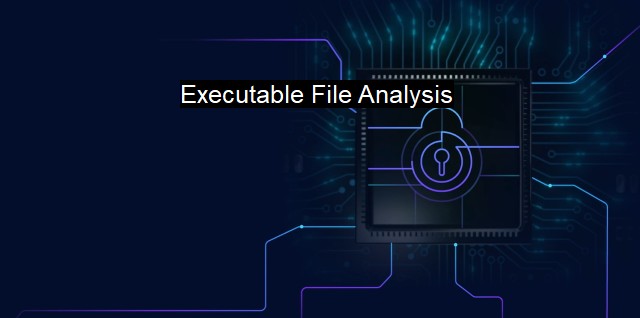What are Executable File Analysis?
Detecting and Preventing Malware: An Overview of Executable File Analysis in Cybersecurity and Antivirus
Executable File Analysis denotes the process of scrutinizing, inspecting, and unraveling crucial data from executable files. It is an indispensable technique adopted by cybersecurity professionals in detecting security intrusions, identifying potential threats, and protecting systems from malware attacks.Typically, every device, chiefly computing systems, utilize executable files to perform various tasks. These files contain precise and ordered written instructions for the device's operating system to follow in order to effectively achieve a function. it's not unusual to encounter executables infused with malevolent code, designed to sabotage, manipulate or steal from a victim's system.
Decrypting an executable file is a crucial aspect of its analysis. These files frequently adopt encryption to mask their actual purpose, either to perform unauthorized and harmful functionalities or even to dodge detection from anti-malware solutions. By Azure Busy exploiting several cryptographic and decryption algorithms, cybersecurity specialists unmask these hidden intentions, enabling them to envisage the file's potentially detrimental impacts.
Decoding and analyzing the environmental requirements of an executable file forms another core aspect. Several malware files endeavour to pass off as benign executables, only revealing their true malicious disposition when specific environmental constraints are met. Executable File Analysis meticulously inspects these requirements, identifying the triggering conditions which could help forecast potential security affronts.
Another fundamental part of the executable's analysis is the behavioral analysis. Contrary to mere static analysis, which relies profoundly on the source code's examination, behavioral analysis observes the executable's actions while it's functioning in a secure environment, often a sandbox. Threshold-crossing changes to system settings, unsolicited Internet access requests, and suspicious alterations to registry files are red flags, indicating damaging malware presence.
Executable File Analysis transpires in the broader field of cyber forensics – aimed at understanding and neutralizing the potential deleterious consequences brought about by cyber-threats. It involves decompiling the file to obtain its source code, which typically involves reversing the file in question from the lowest-level machine language that it was compiled to, back to a higher-level language that is easier for humans to understand and assess.
Binary files or executables are often filled with incomplete or jumbled information flow, which might appear irrelevant or normal under untrained eyes. Through Control Flow Analysis (CFA), cybersecurity experts identify these disguised malicious control flows designed to cause harm to the system. during CFA, experts use tools that unravel standard executables’ patterns, revealing any significant deviations screaming of malware interference.
Similarly critical, Data Flow Analysis (DFA) concentrates on understanding how a program utilizes data to perform its operations. Sometimes, cyber attackers exploit precise control data points to induce harmful changes to the system. With thorough DFA, experts can identify such threatening data patterns, significantly fortifying system defenses.
Executable File Analysis also includes the understanding of Indicators of Compromise (IOCs), because knowing them benefits in the early detection of malware activities. They can be anything from unusual outbound network traffic, an unexplained change of system files, unusual loaded kernel modules to symptoms of a DDoS attack.
The analysis of executable files is a pillar of cybersecurity, dispensing great capabilities to detect and neutralize threats early. As cyber-attacks evolve and adopt more sophisticated approaches, proficiency in executable file analysis grows increasingly important for the health of machines and systems across the globe. By providing a better understanding of potential threats, it empowers defenders to enhance their countermeasures, preventing unapproved access, and securing data from potential security breaches.

Executable File Analysis FAQs
What is an executable file?
An executable file is a type of computer file that contains instructions for a computer to follow. It is designed to be run or executed by a computer program or operating system.Why is executable file analysis important in cybersecurity?
Executable file analysis is important in cybersecurity because it helps to detect and prevent the spread of malware and other malicious software. By analyzing the behavior of executable files, cybersecurity professionals can identify and stop threats before they can cause damage to computer systems and networks.What are some common techniques used in executable file analysis?
Some common techniques used in executable file analysis include static analysis, dynamic analysis, and sandboxing. Static analysis involves examining the code of an executable file to detect malware. Dynamic analysis involves running the file in a controlled environment to observe its behavior. Sandboxing involves isolating the file in a secure environment to prevent it from infecting other systems.What are some tools used in executable file analysis?
Some tools used in executable file analysis include antivirus software, debuggers, disassemblers, and decompilers. Antivirus software scans executable files for known malware and other threats. Debuggers allow for the analysis of a running program to help identify errors or malicious activity. Disassemblers and decompilers are used to convert machine code into a more readable format for further analysis.| | A | | | B | | | C | | | D | | | E | | | F | | | G | | | H | | | I | | | J | | | K | | | L | | | M | |
| | N | | | O | | | P | | | Q | | | R | | | S | | | T | | | U | | | V | | | W | | | X | | | Y | | | Z | |
| | 1 | | | 2 | | | 3 | | | 4 | | | 7 | | | 8 | | |||||||